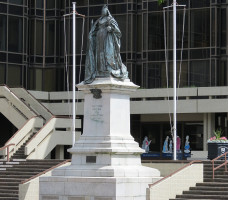 Portsmouth's Queen Victoria, Guildhall Square.
Portsmouth's Queen Victoria, Guildhall Square.
 Portsmouth's Queen Victoria, Guildhall Square.
Portsmouth's Queen Victoria, Guildhall Square.
Portsmouth’s memorial statue of Queen Victoria stands at the opposite side of the broad square by the Town Hall, a great bronze statue raised on a tall stone plinth, square in cross section, and with a heavy base.
Different aspects of Alfred Drury's statue.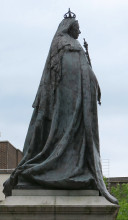
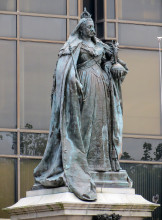
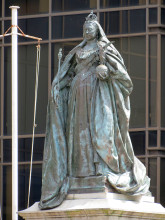
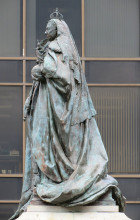
The Queen is shown standing in contemplation, gazing forward and slightly downward, mouth severe; the likeness is considered excellent. On her head is a hood or veil, with crown on top, and above her embroidered skirt and top hung with medals, she wears enveloping robes which hang over her arms, fall over the edge of the base on the left hand side, and lie in a heap of drapery on the right hand side, the best view of which is exactly in profile from the right, where there is a graceful symmetry to the sweep of cloth forward and backward. The overall effect of all this drapery is of course to add mass and gravitas to the statue. In one hand she carries her sceptre, in the other, an orb with small standing figure of a winged Victory upon it, a charming statuette most characteristic of the sculptor, Alfred Drury.
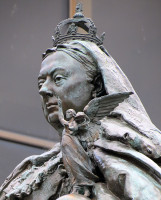
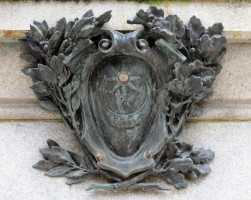 Winged Victory, and arms of Portsmouth.
Winged Victory, and arms of Portsmouth.
Alfred Drury made several statues of Queen Victoria. The Portsmouth one dates from 1903, and a very similar one was emplaced in Bradford in the following year. In 1905, a further copy was put up in Wellington, New Zealand, which is accompanied by three small plaques in high relief on the base. There are no plaques on the base of the Portsmouth Queen Victoria, but a bronze cartouche with a star and crescent moon motif, from the coat of arms of Portsmouth rather than a sideways flag of Turkey, with a leafy branch on either side: oak on the right, olive on the left. Drury also made a stone Queen Victoria statue, much more youthful, for the front of the Victoria and Albert Museum in London.
Back to Portsmouth. The Town Hall itself, renamed as the Guildhall when Portsmouth gained City status in the 1920s, is an extraordinarily grand pile, made more so by the wide flat spaceof Guildhall Square in front of it. The architect was a certain William Hill, and the edifice was erected in 1886-90, apparently being largely based on the smaller Town Hall made by Hill for Bolton some years previously. It was damaged in WW2, and previously had turrets at the corners, and a cupola on the tall central tower. The pediment contains sculpture by H. T. Margetson, with further free-standing groups atop the pediment and in the acroterial positions. At the base of the grand portico are large stone lions, and behind the Corinthian pillars are further decorative figures around the central door.
Portsmouth Town Hall (Guildhall) from by Victoria, the Pediment by H. T. Margetson, and one of the lions.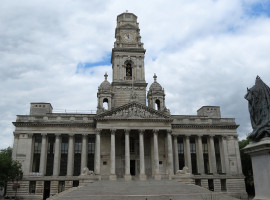

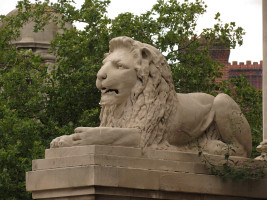
This page was originally part of a 'sculpture of the month' series, for March 2014. Although the older pages in that series have been absorbed within the site, if you would wish to follow the original monthly series, then jump to the next month (Apr 2014) or the previous month (Feb 2014). To continue, go to the bottom of each page where a paragraph like this one allows you to continue to follow the monthly links.
Portsmouth Guildhall sculptures // Portsmouth King's Theatre // Statues in English towns
Alfred Drury // Sculpture pages
Visits to this page from 1 Mar 2014: 2,931 since 10 September 2024